It takes careful planning and attention to detail to grow bell peppers successfully. 10 tips to help you grow tons of bell peppers are listed below:
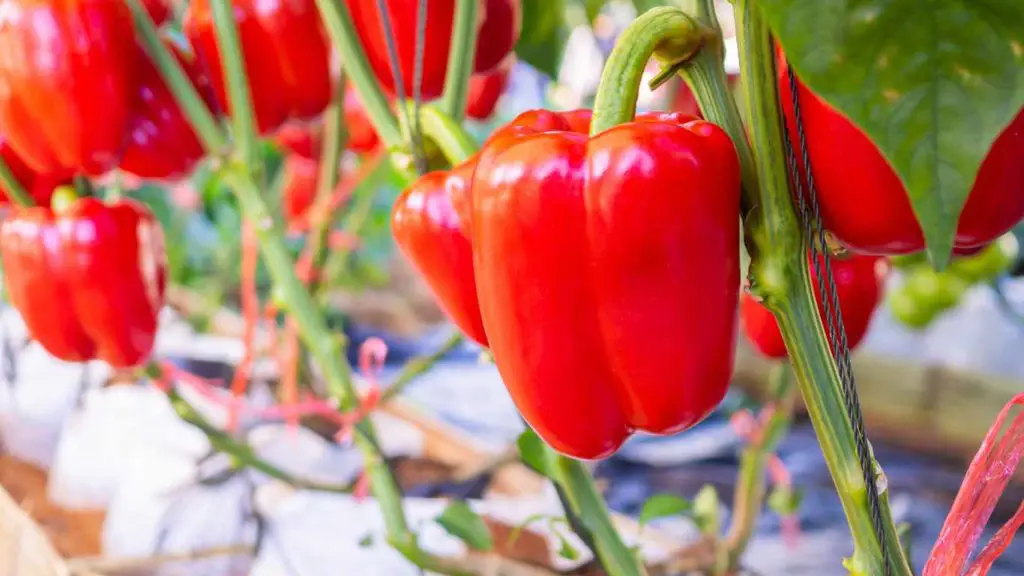
1: Pick the Correct Variety
The type of bell pepper you cultivate will determine how big of a harvest you get. When selecting your choice, take into account many factors such as the intended purpose, taste preferences, available space, and temperature.
Here’s a thorough guide to help you choose the right kind so you can grow buckets of bell peppers:
- Climate and Growth
Choose cultivars that do well in your climate by determining your USDA hardiness zone. Select bell pepper kinds that are appropriate for your region’s climate, as they often prefer warm temperatures and full sun.
Take your growing season’s duration into account. Choose kinds wisely—some are better suited for longer or shorter growing seasons than others.
- Taste Preferences:
Think about your preferred flavor profile. Bell peppers have a range of colors, each with a somewhat distinct flavor. For instance, because they take longer to ripen, red bell peppers are sweeter than green ones.
Make your selection based on your preferred cooking style, as several varieties may have a stronger or spicier flavor.
- Immunity to Disease:
Look for varieties resistant to bacterial wilt, bacterial spot, or pepper mosaic virus, among other common diseases that are frequent in your area. Higher yields and a healthy crop can be guaranteed with the use of disease-resistant cultivars.
- Popular High Yielding Varieties:
California Wonder: is a traditional cultivar that has big, thick fruits and strong disease resistance.
Big Bertha: Distinguished by its big, robust fruits that turn red as they ripen from green.
Yolo Wonder: An early-maturing, uniformly-sized pepper variety that is very productive.
Ace: Generates a lot of medium-sized peppers early on that are ideal for slicing or stuffing.
Gypsy: Provides a variety of hues, such as orange, red, yellow, and green, along with a sweet taste and great yield.
2: Encourage Pollination:
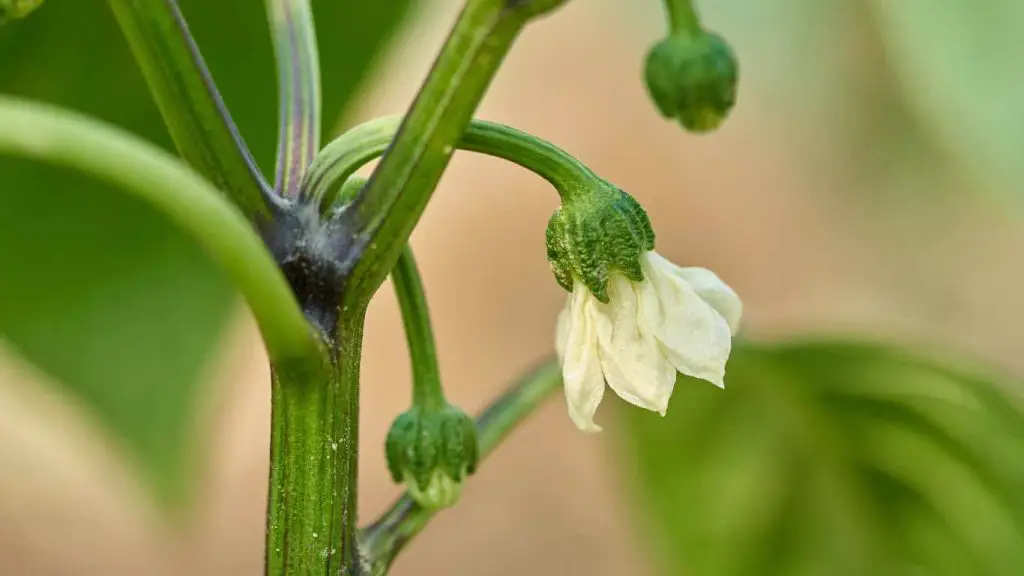
Understanding the natural processes involved, establishing the ideal habitat, and even taking action to aid in pollination are all necessary to promote pollination and increase bell pepper harvests.
Although bell peppers are self-pollinating, help can be beneficial to provide the best possible fruit set and output.
- Understand the pollination:
Recognizing The process by which pollen is transferred from a flower’s male reproductive organ, the anther, to its female reproductive organ, the stigma.
Bell peppers can self-pollinate or utilize pollinators such as bees, butterflies, or wind to aid in the process.
- Building an Environment That Is Pollinator-Friendly:
Your garden’s output of bell peppers can be greatly increased by attracting pollinators. Pollinators can be attracted to a range of flowers, including lavender, marigolds, and bee balm, which can serve as a food source and habitat for them.
It’s also critical to refrain from using pesticides that are toxic to bees and other pollinators.
- Stir Things Up:
In situations where natural pollinators are in short supply, bell pepper plants may benefit from manual pollination. When blossoms are open, gently shaking the plants might aid in improving the fruit set and spreading pollen. Pollen can also be moved between blooms using a little brush.
- Keep an eye out for diseases and pests:
These conditions can prevent pollination and lower bell pepper harvests. Examine your plants frequently for indications of illnesses like blossom end rot or pests like aphids, and take the necessary action to eradicate them.
3: Begin with Healthy Soil:
Having healthy soil is essential to cultivating an abundance of bell peppers. First, ensure your soil’s pH is appropriate; it should be between 6.0 and 7.0.
You can do this by adding amendments such as sulfur or lime. Add organic matter to your soil, such as old manure or compost, to help with water retention, soil structure, and nutrient availability. This increases microbial activity, which is essential for plants to absorb nutrients.
Check the nutrient levels in your soil on a regular basis and add organic fertilizers that are high in potassium, phosphorus, and nitrogen when needed for healthy plant development and fruit production.
Mulching around plants aids in soil temperature stability, weed control, and moisture retention.
4: Provide Enough Sunlight:
For bell peppers to grow and develop properly, they need to be grown in buckets with adequate sunlight. Warm-season veggies like bell peppers need lots of sunshine, warmth, and well-drained soil to grow effectively.
Here’s a detailed instruction explaining how to make sure they get enough sunlight:
- Choosing the Ideal Spot:
Pick a spot in your garden or on your balcony that gets at least 6 to 8 hours of direct sunlight each day. Choose a location that receives lots of sunlight and warmth throughout the day because bell peppers appreciate these conditions.
- Avoiding Shade:
Keep the bell pepper plants away from any tall trees, structures, or other anything that could block sunlight and create shade. Make sure the plants receive full sun exposure all day long because even a little shade might stunt their development and yield.
- Keeping an Eye on Sun Patterns:
Pay attention to the way the sun moves during the day and throughout the seasons in the area you have selected. Since the angle and strength of sunlight vary with the seasons, move the buckets around to maximize their exposure to the sun.
5: Feed Frequently:
Throughout the growth season, fertilize your bell pepper plants to make sure they have access to vital nutrients. Apply fertilizer according to the manufacturer’s recommended rates, using a balanced product or one made especially for vegetables.
- Fertilize Often:
Bell peppers need frequent fertilization because plants are heavy feeders. During the growing season, use a balanced fertilizer—such as 10-10-10 or 5-10-10—that is high in potassium and phosphate every two weeks.
- Monitor Nutrient Levels:
Keep an eye out for symptoms of nutrient deficiencies, such as yellowing leaves or stunted development, on the foliage of the plant. Adapt fertilization as necessary.
- Liquid Fertilizer:
For a rapid nutrient boost, think about supplementing with liquid fertilizer applied every 7–10 days, such as seaweed extract or fish emulsion.
- Light:
For best development and fruit production, provide 6 to 8 hours of direct sunlight each day.
6: Support Heavy Fruits:
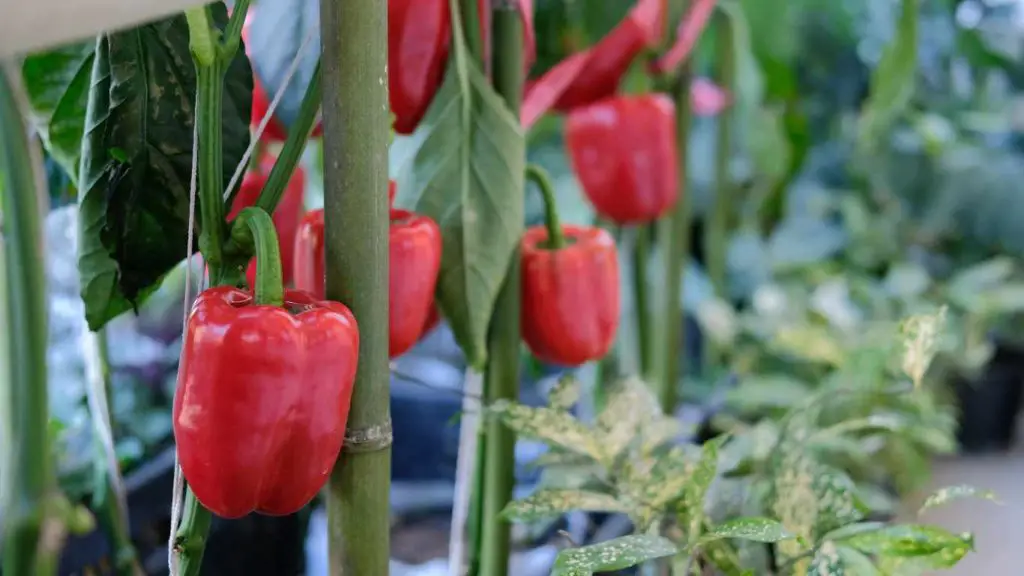
Bell pepper plants may require assistance to keep their branches from snapping under the weight of fully ripe fruits. To keep your plants upright, especially as the peppers start to mature and ripen, stake or cage them.
- Robust Support Structure:
Utilize robust trellises or stakes to sustain the weight of the plants and their fruit. To keep these supports from toppling over, make sure they are securely fixed in the ground or bucket.
- Tying Up Foliage:
Using soft garden twine or plant ties, firmly fasten the bell pepper plants to the support framework as they grow. By doing this, the plants are less likely to break or bend beneath the weight of the fruit.
7: Watch Out For Common Pests And Illnesses:
Keep your garden tidy by routinely pulling weeds, leaves, and garbage. By doing this, illnesses and pests have fewer places to hide.
- Plant companion plants:
Plant plants that can ward off pests and draw beneficial insects that feed on pests, like marigolds, basil, and onions.
- Proper watering:
Watering your bell pepper plants properly means soaking the baseball of the plant in water to prevent moisture-induced disease attraction. Steer clear of overhead irrigation, especially after dark.
- Mulching:
To keep moisture in the soil, inhibit weed growth, and stop soil-borne illnesses from soaking into the leaves of your bell pepper plants, mulch the area surrounding them.
8: Rotate Crops:
Plant bell peppers in different parts of your garden each year to engage in crop rotation, which helps keep pests and illnesses from accumulating in the soil. To interrupt the cycles of pests and diseases, alternate them with unrelated crops like beans, tomatoes, or cucumbers.
Crop rotation is a highly effective method for preserving soil fertility and averting pests and illnesses. Consider switching up your crop rotation to include leafy greens like lettuce or spinach one season, nitrogen-fixing legumes like beans or peas the next, and finally bell peppers in buckets.
In addition to lowering the risk of pests and illnesses that could harm bell peppers, this helps restore nutrients to the soil. For best bell pepper production, also make sure you have enough sunlight, water, and fertilizer control.
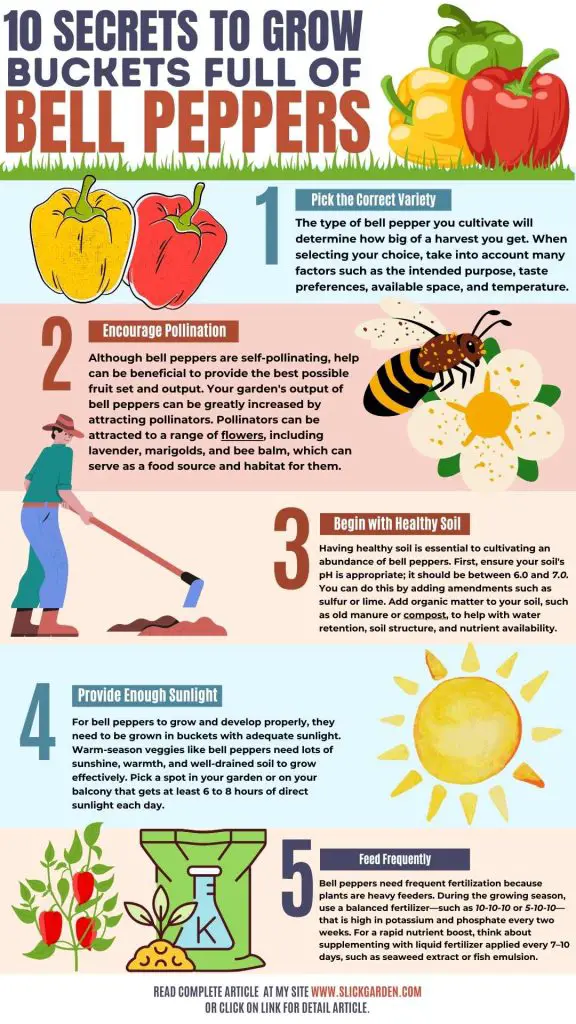
Related Articles:
- How To Grow Bell Peppers From Scraps?
- How To Amend Clay Soil For Vegetable Gardening?
- 20 Best Vegetables To Grow In Buckets
9: Recognizing the Significance of Pruning:
Pruning is the act of eliminating specific sections of a plant in order to promote healthy development and increase production. Pruning is essential for bell peppers since it facilitates airflow, sunlight penetration, and disease resistance.
You may help the plant focus its efforts on producing more fruit by pruning off non-productive branches and extra foliage, which will lead to larger and more peppers.
- When Should Bell Peppers Be Pruned?
Bell pepper plants should be pruned as soon as they become established and begin to produce blossom buds.
This usually happens when the plants reach a height of 6 to 8 inches. Early pruning aids in shaping the growth of the plant and promotes the creation of robust, fruitful branches.
- Pruning methods for bell peppers include:
a. Eliminating suckers, which are tiny shoots that sprout from the main stem’s leaf axils. Even though they might grow into branches, they might cause congestion since they frequently fight for nutrients with the main stem.
Using your fingers or sterile pruning shears, carefully pinch off suckers to divert the plant’s energy toward fruit production.
b. Thinning Out Foliage:
As bell pepper plants get older, they may develop a lot of foliage. By chopping off older leaves and congested branches, you can thin out the foliage and improve airflow and solar penetration to the developing fruits.
Take care not to remove too many leaves because they are essential to photosynthesis.
c. Pruning Injured or Diseased Branches:
Check your bell pepper plants frequently for indications of illness or injury. Cut off any impacted leaves or branches right once to stop infections from spreading and maintain the plant’s general health. To prevent contamination, dispose of waste that has been clipped away from the garden.
10: When to Harvest:
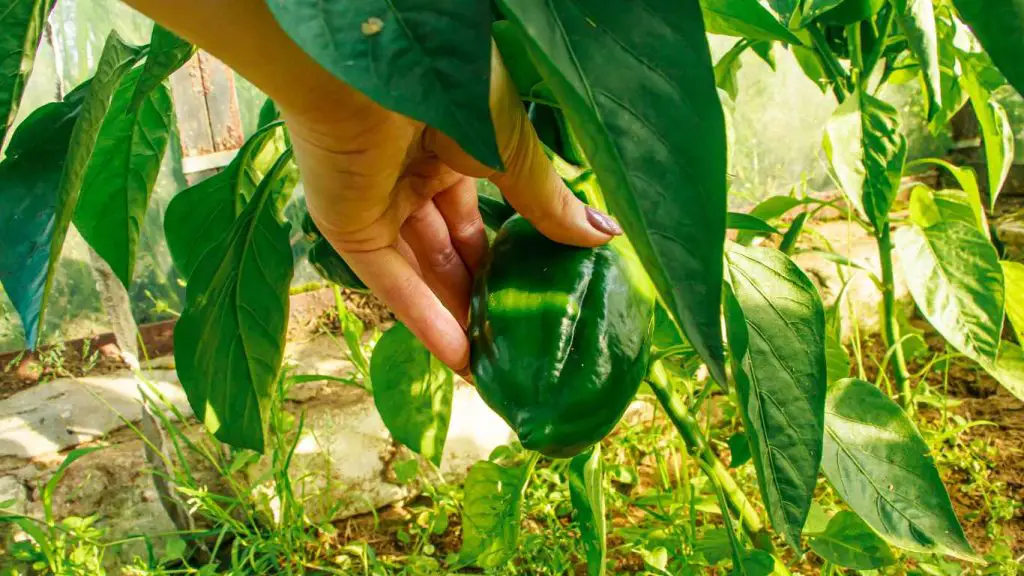
Don’t harvest your bell peppers until they are fully grown in size and color. Some kinds can be harvested at the green stage if desired, but most varieties will turn red, yellow, or orange as they ripen.
To remove the peppers from the plant, use pruners or scissors, being careful not to cut the stems.
Conclusion:
You may grow an abundance of bell peppers in your garden and have a plentiful harvest all through the growing season if you adhere to these ten tips. Buckets full of delicious peppers to enjoy and share with friends and family are the result of good care, attention to detail, and a little patience. Cheers to your successful gardening!
